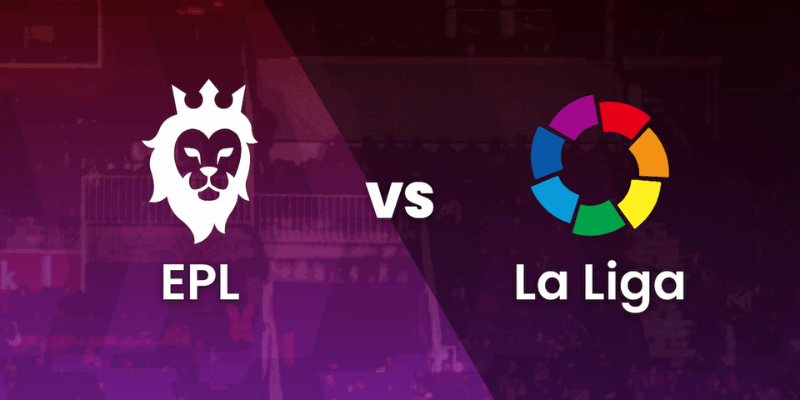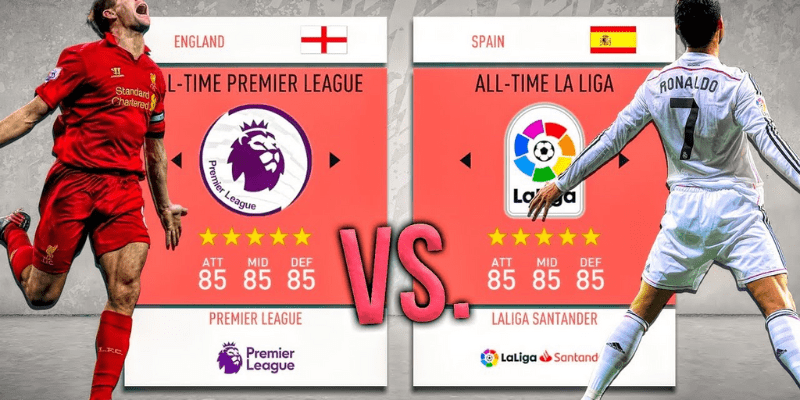In the great football debate, one of the most asked questions is the difference between La Liga and Premier League — and there’s more than meets the eye. These are two of the world’s biggest leagues, each with its own style, culture, and economics. In this article, AdiyaBall will take you through what really makes the Premier League and La Liga unique —.
Style of play and tactical philosophy

One of the sharpest contrasts between La Liga and the Premier League is how teams play.
La Liga’s technical artistry
La Liga tends to emphasize:
- Tight ball control, patient build-up, and sustained possession. Passing patterns are often more intricate, with focus on keeping the ball, probing defense, and breaking lines slowly.
- Tactical variation: teams like Real Madrid, Barcelona, Atlético Madrid, Sevilla all have different identities — possession-dominant, counter-attacking, high press, or deep defense.
- Lower tempo on average compared to Premier League, which allows more time for players to create, dribble, and make creative decisions.
Premier League’s intensity and pace
By contrast, the Premier League is known for:
- Fast-paced, physical football. Pressing, high energy, quick transitions (defense into attack) are more common.
- A higher tempo: more running, end-to-end action, often less time on the ball.
- Greater variance in how teams approach matches:.
Competitiveness and League Balance

How tight are the races? How many teams realistically challenge for top spots, and how often do underdogs upset the big clubs?
- The Premier League tends to show greater parity outside its very elite clubs. Surprises happen more often. For example, mid-table or lower clubs can beat “top six” sides, sometimes over multiple matches in a season.
- In La Liga, while smaller clubs sometimes make waves, the dominance of the top three/four clubs is more entrenched. Title races are more frequently a battle among a few.
So, in terms of unpredictability and “anyone can win on their day,” the Premier League usually has the edge.
Financials: Revenue, spending & power

Euro-football is also very much about money — and here the Premier League has pulled ahead in recent years.
- Recent finance reports show the Premier League generating around double the revenue of La Liga. For example, in 2023-24, Premier League clubs earned roughly €7.1 billion, whereas La Liga pulled in about €3.7 billion. This massive difference gives English clubs more resources.
- Big transfer windows: The Premier League’s spending on player transfers is much larger. In the summer of 2025, clubs in England spent around €2.4 billion, which was about five times more than La Liga for that samendow.
- Broadcasting rights: England’s domestic + international TV contracts are far more lucrative. This inflow supports higher player wages, better infrastructure, and more competitive squads across more teams.
Fan engagement, stadium atmosphere and attendance
Matches are more than money and tactics — the crowd, atmospherend global reach matter too.
- Average attendances are typically higher in the Premier League. More stadiums filled to capacity, often in bigger venues, contribute to loud, physical atmospheres.
- La Liga has passionate fans, and many of their smaller club stadiums are full of character, but overall capacity and utilization tend to lag behind England.
- Globally, the Premier League has arguably broader TV viewership, more overseas rights deals, and more consistent exposure in markets like Asia, North America, and Africa.
European success and reputation
How do clubs in both leagues perform when they step onto the larger stage — Champions League, Europa League, etc.?
- La Liga clubs have a rich history in European competitions. Real Madrid’s Champions League history is unmatched; Barcelona has also won multiple times. Sevilla has been extremely successful in Europa / Europa Conference levels.
- The Premier League has also delivered, but over many years the English clubs have had ups and downs. In some recent seasons, teams like Manchester City, Liverpool, Chelsea have reached finals or won. But La Liga’s elite still often dominate in terms of total number of Champions League trophies.
Player development, youth systems, and global stars
Where do the stars come from, and which league better nurtures them?
- Spain’s youth academies are famous for producing technically gifted, tactically intelligent players. There is a strong culture of integrating young talent into first teams.
- The Premier League draws talent globally — buying young stars and big names.
Modern trends and future outlook
The gap is dynamic. Both leagues are evolving.
- La Liga is working to modernize its commercial strategies, seek more global TV revenue, and reduce financial disparities among clubs.
- The Premier League may continue to dominate monetarily, but with rising cost pressures (wages, transfers, regulation) and expectations around competitive equity.
- Fan demand for style vs. spectacle: some fans prefer the flair and technical beauty of La Liga; others want constant action, physicality, and unpredictability, which the Premier League offers.
Conclusion
In this article, AdiyaBall has explored the many facets of the difference between La Liga and Premier League. Both are world-class; both bring unique magic. If you value artistry, technical finesse, and storied rivalries, La Liga shines. If you love breathless pace, intense battles, unpredictable results, and financial muscle, the Premier League delivers like few others.
So which do you prefer? Leave a comment below, tell us your pick—and stick around AdiyaBall for more deep dives, match analyses, player stats, and transfer stories.






